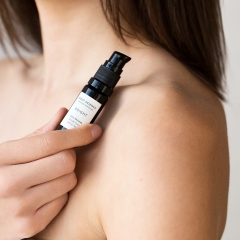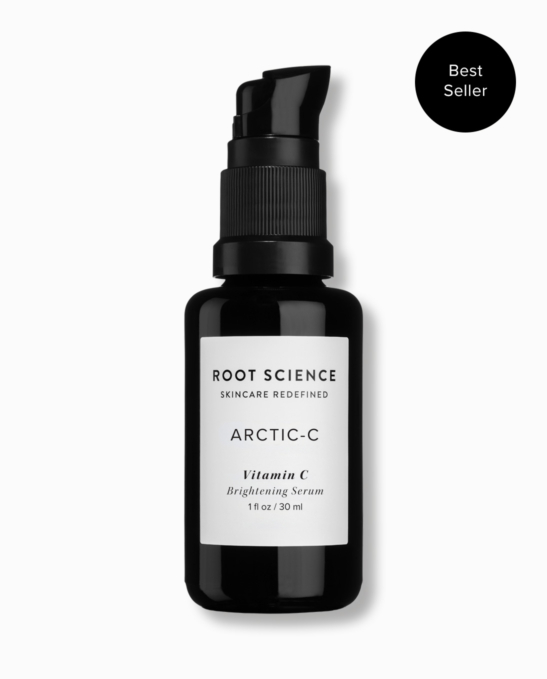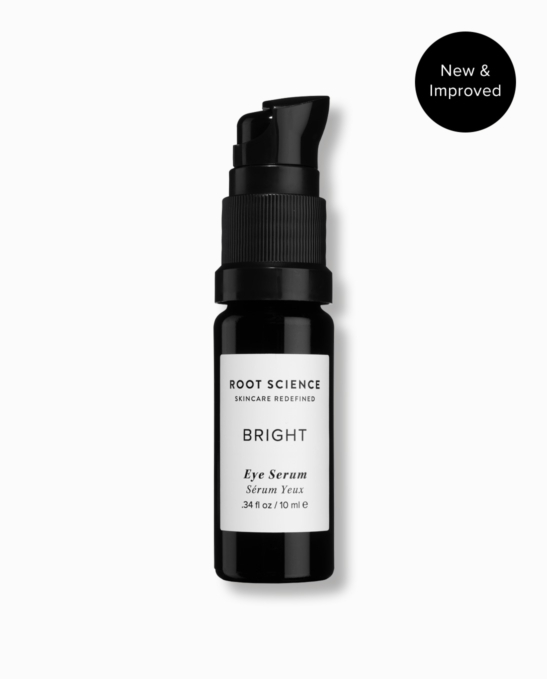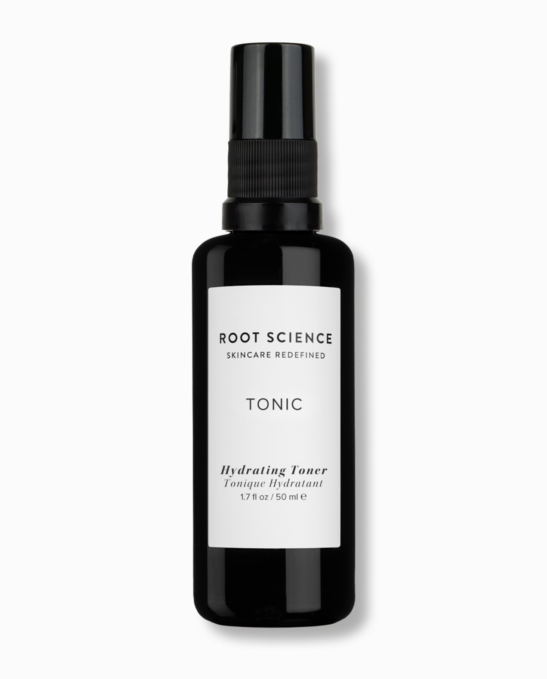If you suffer from chronically dry skin around your eyes, we’re here to help!
You may be surprised to learn that having dry skin around the eyes is a pretty common skin issue that many people experience. The good news is that it can be easily take care of — without having to turn to extreme measures.
Keep reading for our 7 natural solutions (that actually work) to soften dry skin around your eyes while simultaneously promoting healthy-looking skin. These tried and true solutions will also help to minimize the look of fine lines and wrinkles, a win, win!
What Causes Dry Skin Around The Eyes?
The skin around the eyes is thinner than the skin on the rest of your face. It has less oil glands, resulting in less sebum produced, aka your bodies’ natural moisturizer. This makes the skin around our eyes more susceptible to dryness, fine lines and wrinkles.
Furthermore, as we age our skin becomes drier due to a natural decrease in sebum production. Biological factors are not the only cause for dry skin around the eyes, however. What you put on your skin could be negatively affecting it. Harsh cleansers, improperly formulated skincare (sadly this is common) and makeup can dry out the skin. Also, as we mentioned, since there are less oil glands around your eyes, it’s especially important to avoid using products that strip your skin of moisture.
For all the reasons above, it’s vital that we take care of the delicate skin around the eyes properly, by using biocompatible moisture treatments (more on what that means below) and promoting your best skin through internal and external efforts. This may sound complicated, but it’s actually quite simple.
7 Natural Solutions For Dry Skin Around The Eyes
1. Switch To An Oil Cleanser (And enjoy the glow)
Oil cleansing is an ancient technique that’s making its way back into modern day skincare regimens. This is due to its gentle, yet highly effective ability to deep clean the skin, remove makeup and SPF — without stripping the skin of moisture.
We recommend selecting an oil cleanser that does not contain foaming agents, fragrance or essential oils, as they can irritate dry skin around your eyes. They can also sometimes sting, causing further skin imbalances such as redness and irritation. Look for oil cleansers that include skin-loving oils such as jojoba, black cumin, oat, and sea buckthorn.
Shop our favorite and most trusted organic Jojoba oil here.
2. Use Honey As A Natural Eye Mask (Baby soft skin is a guarantee)
Honey is a gentle ingredient with numerous skin benefits. This makes it especially useful for sensitive and dry skin around the eyes. Honey works to gently exfoliate, smoothing and softening the dry skin. It also acts as a humectant, providing hydration benefits.
Honey contains potent vitamins, minerals and antioxidants, which help to visibly rejuvenate and refresh tired-looking skin around the eyes. Just be forewarned that your pup will come begging for some sweet kisses, that’s a guarantee. Use 1-2 times per week and leave on skin for 15-30 minutes.
In addition to working as a healthy eye area mask, honey can be used as a non-stripping facial cleanser. It’s especially ideal for morning facial cleansing and as an evening cleanser on days you don’t wear makeup or SPF.
Shop our favorite and most trusted pure Honey here.
3. Hydrate (Not the way you think)
You most likely already know that you should be drinking plenty of water throughout the day. However, you also want to make sure your body is holding on to that hydration by eating foods with high water and nutrient content.
Some of our favorite, nutritionally-dense foods that help us hydrate our skin from the inside include: cucumber, lettuce, avocado, berries, cantaloupe and honeydew melon. It’s easier for your body (and skin) to retain hydration when it comes from whole foods.

Organic. Phytoactive. Skin Nourishment.
Looking To Nourish The Delicate Skin Around Your Eyes?
4. Swap Out Your Cream For A Biocompatible Eye Oil (Dewy skin is in your future)
Your skin produces oil, aka sebum, to keep it moisturized and protected. So naturally it makes sense to use ingredients that resemble our sebum, such as squalene and jojoba, to replenish the moisture our skin is having a hard time producing on its own. Our skin is able to recognize these ingredients due to the fact that their chemical makeup is similar to that of human sebum – so our skin readily absorbs these ingredients. This simple swap also helps you avoid exposing your skin to harsh preservatives and oftentimes harmful synthetics found in eye creams. Our Bright eye serum is strategically formulated to care for the sensitive eye area, delivering a serum that is light in texture and equipped with scientifically evaluated botanical oils and plant extracts that not only soften dry skin, but also help to visibly firm, brighten and plump.
5. Use A Glycerin-Based Product for Topical Hydration (Don’t let fads compromise your healthy skin)
Your skin needs hydration and moisture. Oils cannot hydrate the skin as they do not attract or hold on to water. This is why it’s so important to use a hydrating treatment that includes humectants.
What’s a humectant you ask? Ingredients that bind to water and keep it from evaporating, thus keeping your skin hydrated. This is why simple face mists (liker rose water) without humectants can make your skin feel dry or itchy once they evaporate, because they aren’t doing much for your skin, beyond their sensory experience.
Some of the most common humectants used in skincare include glycerin, urea, propylene glycol and hyaluronic acid (which is having its 15 minutes of fame due to a major marketing push, however, industry insiders know that it’s mostly hype). Glycerin, though not trendy or fancy sounding, is a tried and true skin hydrator that’s compatible with most skin types, including sensitive and blemish-prone, and has numerous skin benefits. Glycerin replenishes your skin’s natural moisturizing factor and is readily absorbed, helping to hydrate the skin, as well as transport active ingredients.
To effectively manage chronic dryness around the eyes and keep it from coming back, it’s vital to not only replenish moisture, but also hydration. You do this by simply mixing in a few drops of a water-based treatment that includes glycerin, such as our Tonic hydrating toner, into your oil-based eye serum — creating a balanced water-to-oil ratio. This combination helps to give your skin long-lasting moisture.
6. Apply Topical Nutrients (Cheers to your best skin)
Nutrients help your skin look its best. When your skin is prone to dryness, it’s not enough to simply replenish the moisture your skin is having a hard time producing. It’s also helpful to use topical nutrients that promote healthy-looking skin.
Some of the best nutrients for maintaining your best skin can be found in botanical oils and plant extracts. Reach for an eye serum that includes nutrient-rich botanical oils and extracts such as sea buckthorn, oat and astaxanthin.
However, some nutrients must be lab made due to their fragile nature, meaning they don’t exist in natural cosmetic ingredients due to a break down during the extraction process. This is especially true for vitamin C, a notoriously unstable vitamin with amazing skin benefits. This is why we recommend a stable and gentle form of vitamin C that goes by the name of tetrahexyldecyl ascorbate. But don’t be intimidated by its not so reader-friendly name, it’s simply a fat-soluble vitamin C derivative.
7. Incorporate Healthy Fats (Plump skin here we come)
You probably weren’t expecting to hear this, but truth be told, no one ingredient, skincare product or tool can solve all your skin woes if your diet is unhealthy. The foundation for healthy-looking skin starts on the inside, therefor a nutrient-rich diet plays a vital part in helping you to maintain your best skin.
A diet rich in skin-loving nutrients like healthy fats and protective antioxidants is great for overall health (not to mention slows those beloved signs of life, aka wrinkles and fine lines).
We recommend cutting out inflammatory cooking oils such as canola and vegetable oil and replacing them with healthy alternatives such as cold-pressed olive oil (however, don’t cook with virgin olive oil).
You also want to make sure you are getting enough anti-inflammatory omega-3 fatty acids found in fatty fish like salmon and sardines. Vegan sources of omega-3 fatty acids include walnuts, chia seeds and flaxseeds. We highly suggest getting familiar with the basics of an anti-inflammatory diet to help guide you in choosing foods that support your skin health.
The Bottom Line
1. Swap out your foaming cleanser for an oil cleanser.
2. Use pure honey as an eye area mask 1-2 times per week.
3. Incorporate hydrating foods into your diet.
4. Use biocompatible moisturizing oils.
5. Hydrate your skin with a glycerin-based treatment.
6. Incorporate topical nutrients to promote healthy-looking skin.
7. Incorporate healthy fats into your diet.
If you have any questions or concerns about your skin, don’t hesitate to reach out — we love to talk skin!
Shop Featured Products
Disclaimer: This content is for informational and educational purposes only. It is not intended to provide medical advice or to take the place of such advice or treatment from a personal physician. All readers/viewers of this content are advised to consult their doctors or qualified health professionals regarding specific health questions. Neither Root Science nor the publisher of this content takes responsibility for possible health consequences of any person or persons reading or following the information in this educational content. All viewers of this content, especially those taking prescription or over-the-counter medications, should consult their physicians before beginning any skincare, nutrition, supplement or lifestyle program. The views and products expressed are not intended to treat, cure or prevent any disease.
Image Sources: Woman with Brown Curly Hair via Audrey Fretz / Woman’s Eye via Chermiti Mohamed




